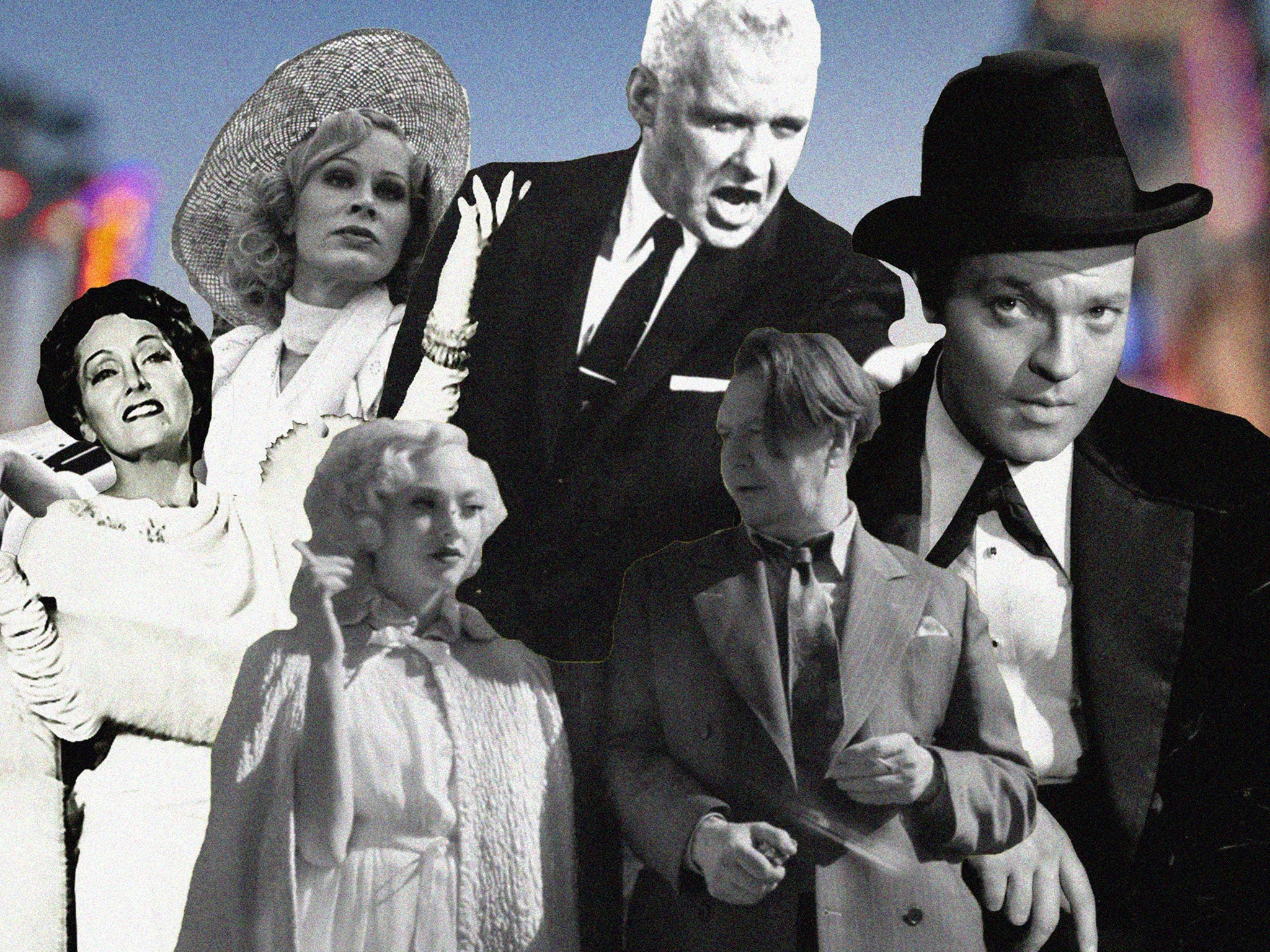
I n David Fincher’s new film Mank, Old Hollywood is piling up its victims. It’s a movie that recreates cinema’s golden age in shimmering silver while depicting classic Hollywood as a place of intellectual bankruptcy, run by reactionary bullies. And in doing so, it tackles a subject that has always been close to Hollywood’s heart: itself.
At the centre is Herman J Mankiewicz (Gary Oldman), the troubled screenwriter behind (at least some of) Orson Welles’s Citizen Kane. We meet Herman head-to-toe in plaster after a car crash, in need of a stiff drink, and under pressure from the Hollywood establishment as he fashions a script based on the life of media mogul William Randolph Hearst. In flashback, we’re taken to Paramount and MGM in the 1930s, and to Mank’s time at Hearst’s San Simeon estate, where he became a drunken court jester to the industry elite, a role that incinerates his self-respect.
For all of its glitz and accomplishments, Tinseltown has a long and proud history of self-loathing. According to many of its own movies, Old Hollywood was where people traded integrity and talent for fortune and fame, betraying their friends, their lovers and themselves.
It hadn’t always felt that way. Back in the Twenties and Thirties, Hollywood talked about itself in broadly celebratory terms. This was an industry seduced by its own glamour and busy defining its own mythology. The standard narrative, seen in films like Ella Cinders (1926) and Movie Crazy (1932), was of a naïve young actor who arrives from a small town, suffers setback and heartbreak, but has enough pluck or luck to somehow come good. Though these movies were often irreverent, they sold the Hollywood fantasy.
In those days, a few films began to grasp the darkness beneath the dream. A Star Is Born (1937), the towering Hollywood heartbreaker, contrasted the stock story with a starker one. As actor Janet Gaynor rises to prominence, her husband Fredric March sees his star power begin to slip, and disappears into an alcoholic abyss. Though the film offers perhaps the most potent version of the original Hollywood myth, Lionel Stander’s sadistic press agent anticipates the viciously self-critical movies that were to come in the 1950s.
Fredric March and Janet Gaynor in ‘A Star is Born’ (1937) (Rex)
In the meantime, Hollywood’s introspection consisted mostly of wondering whether the films it was making were any good. In Mank, William Randolph Hearst (Charles Dance) laments that the studios are neglecting “real literary minds” in favour of gangster movies and comedies. That tussle between “important” films and escapism has fascinated and tormented the industry since its earliest days. Marion Davies, who had an affair with Hearst, starred in a terrific silent comedy called Show People, which waged war on pomposity, but nevertheless ended with its former slapstick clowns going off to make a military drama.
But by 1941, in the wake of the Depression and with actual war on the horizon, the purpose of cinema had evolved. Now the question was whether Hollywood had a duty to confront societal ills. The discourse is best summed up by an exchange from Preston Sturges’s immortal comedy, Sullivan’s Travels, in which film director John L Sullivan and studio executive Mr Hadrian discuss the worthy drama they’ve just watched.
Independent Culture Newsletter The best in film, music TV & radio straight to your inbox every week Please enter your email address Please enter a valid email address Please enter a valid email address SIGN UP Thanks for signing up to the Independent Culture newsletter {{#verifyErrors}} {{message}} {{/verifyErrors}} {{^verifyErrors}} {{message}} {{/verifyErrors}} The Independent would like to keep you informed about offers, events and updates by email, please tick the box if you would like to be contacted
Read our full mailing list consent terms here Independent Culture Newsletter The best in film, music TV & radio straight to your inbox every week The Independent would like to keep you informed about offers, events and updates by email, please tick the box if you would like to be contacted
Read our full mailing list consent terms here
Sullivan: “You see the symbolism of it? Capital and labour destroy each other. It teaches a lesson: a moral lesson. It has social significance.”
Hadrian: “Who wants to see that kind of stuff? It gives me the creeps.”
Joel McCrea plays the pretentious Sullivan, sick of making disposable fare like Ants in Your Plants of 1939, who strives to create “a true canvas of the suffering of humanity” (though he consents to putting “a little sex in it”). Aware of his privilege, he resolves to learn about “trouble”, but finds more than he ever bargained for, only for the joy of escapist cinema to reach him in the dark. The movie is a hymn to entertainment, dedicated “to the memory of those who made us laugh”, but it is also a Trojan horse of a film, enduringly profound on the subjects of art, poverty and common kindness.
Louis B Mayer would have sided with Mr Hadrian. In Mank, the MGM studio chief (played by Arliss Howard) is dismissive of meaningful movies. When he quips, “You want to send a message? Call Western Union,” he’s echoing a line from the 1955 film, The Big Knife – the dark and nasty culmination of a five-year period in which Hollywood went for itself with a scalpel. There are several possible explanations for the darkening mood: a slackening of censorship, a changing of the guard at the top of the studios. Or perhaps the growing shadow of the communist witch-hunt within the movie industry, during which a congressional committee claimed that propaganda was being slipped into films and began blacklisting suspects, leaving many actors, writers and directors unable to work.
This cycle of cynical films about Hollywood began with Nicholas Ray’s In a Lonely Place (1950), which starred Humphrey Bogart as a violently misogynistic screenwriter, and moved through Sunset Boulevard, The Bad and the Beautiful and The Big Knife. These were bitter and bilious movies that became increasingly unhinged. They were about being trapped. And they were fixated on betrayal, whether that was sexual infidelity, the abandonment of one’s ideals or Hollywood’s contempt for its own fallen gods.
Ray’s movie features Robert Warwick as a fine actor turned drunken embarrassment, accepting handouts but despised by those who owe him a greater debt. Billy Wilder upped the ante in his masterpiece, Sunset Boulevard, which centres on former star Norma Desmond (Gloria Swanson), a vainglorious recluse undone by her own hubris and the coming of sound. Though Singin’ in the Rain had fun with the idea of the silent icon rendered obsolete by the new medium, these monochrome melodramas looked at Hollywood’s casualties and saw only a failure of humanity.
MGM’s contribution, The Bad and the Beautiful, was predictably glossy but unexpectedly cruel, focusing on a ruthless producer (Kirk Douglas) and ending each of its three acts with a betrayal. The second inspires a fantastic freak-out from Lana Turner behind the wheel of a moving car. She’s the damaged daughter of a dead star; by 1952, Hollywood doesn’t just kill you, it curses your children, long after you’re gone. But where the film differs from the others is in suggesting that all this pain is worthwhile, perhaps even justified, in the service of great movies.
The Big Knife, based on a play by Clifford Odets, would offer no such mitigation. Odets – the inspiration for the Coen brothers’ 1991 black comedy, Barton Fink – had been the toast of New York in the mid-Thirties, renowned for hard-hitting socialist agitprop like Waiting for Lefty, before being lured to Hollywood. What he found there formed the basis of The Big Knife, brought to the screen in 1955. The subsequent film is one long howl of self-pity and self-righteousness, a portentous, inert and occasionally brilliant movie about “a man who sold out his dreams, but he can’t forget them”.
Jack Palance and Shelley Winters in ‘The Big Knife’ (1955) (Rex)
Hollywood star Charlie Castle (Jack Palance) is that man, who betrays everything he loves, before being blackmailed by psychotic, weepy studio head Stanley Shriner Hoff, played like a mob boss by Rod Steiger. Hoff’s press agent, meanwhile, hopes to kill a scandal by killing a young woman. In two decades, films about Hollywood had transmuted from buoyant comedies about stardom to corrosive dramas of self-abasement, in which at least one person ends up dead.
You may think that a movie as vituperative as The Big Knife would mark the low point in Hollywood’s treatment of itself. You would be wrong.
For that, the town had to see itself through the eyes of the blacklisted.
One of the victims of the communist witch-hunt had been screenwriter Waldo Salt, excluded in 1951. It may explain why his screenplay for 1975’s The Day of the Locust depicts Old Hollywood as essentially hell on earth. In Sunset Boulevard, Hollywood was described as a “stinking town”. In Salt’s script, that has escalated: it is a “mecca of broken dreams”, “a disaster area”. Though he adapted it from a Nathanael West novel – published in 1939, the year that Hollywood made both Gone with the Wind and The Wizard of Oz – neither phrase appears in West’s book.
The Day of the Locust portrays Hollywood as a place of naked self-interest, populated by venal characters whose only depths are of desperation and depravity. Karen Black’s blonde starlet enjoys an ice cream while ignoring a tour guide’s account of Peg Entwistle’s tragic demise – the 24-year-old actor’s leap from the Hollywood sign being folded into folklore – and is later oblivious to a newsreel about Hitler coming to prominence, as she’s annoyed to have just had her best moment cut from a musical. Like its novel, Locust climaxes with an explosion of violence at a premiere, the seething masses ripe for fascism.
✕ Trailer for Mank
By comparison, Mank seems positively restrained. It does evoke Hollywood’s reactionary politics through MGM’s involvement in the 1934 California gubernatorial race; the studio’s opposition to socialist Upton Sinclair included the production of fake news, in the shape of phony newsreels. But perhaps the most alarming element of Fincher’s film is actually a sin of omission. There were several great female screenwriters during this period, including Frances Marion – who worked with Mankiewicz on Dinner at Eight – and Dorothy Parker, who co-wrote A Star Is Born. And yet the only woman shown in a studio writers’ room during Mank is nameless, topless and mute.
With distance from its subject, Mank is able to revel in Old Hollywood’s trappings while abhorring many of its traps. It is shown as a place of latent viciousness and rampant hypocrisy, where the meek are chewed up and great writers are forced to churn out dreck, and yet it retains that seductive sparkle. While you might expect a Fincher film to be darker than its antecedents, Mank instead combines different parts of a complicated tradition, sharing the scotch-fuelled bitterness and human cost of the Fifties cycle, but aping the fast-talking style of Thirties comedies such as Boy Meets Girl, and allowing its hero to triumph over adversity – just like in Movie Crazy.







